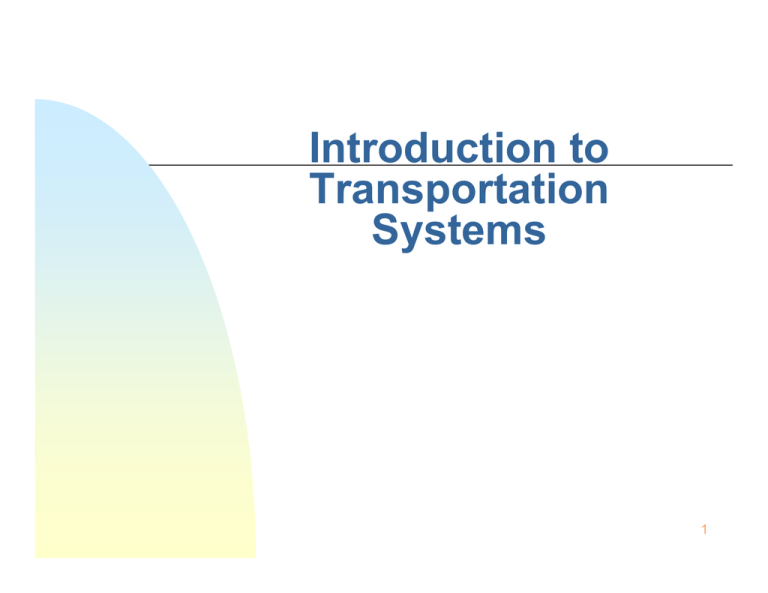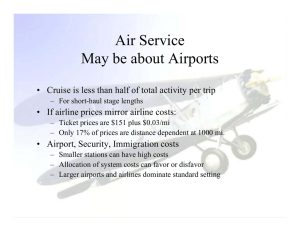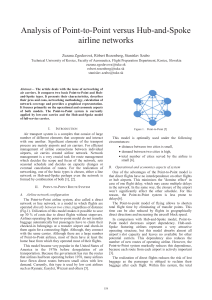Document 13504079
advertisement

Introduction to Transportation Systems 1 PART III: TRAVELER TRANSPORTATION 2 Chapter 29: Intercity Traveler Transportation: Air 3 Air Traveler Transportation Costs/Financial Situation Air Traveler Transportation and the 30 “Key Points” Land-side Issues Airport Access Airport Terminal Design Important Issues Stochasticity Peaking Selecting Capacity Network Behavior Airport Capacity Hub-and-Spoke Operation Safety Aircraft Technology Yield Management Understanding the Air Traveler Market Subsidies -- Air as an example 4 Airline Costs and Financial Situation Labor Costs Fuel Costs Equipment Costs 5 Reasons for Air Industry Financial Problems Competition is the critical element. There are those that would argue that the industry has more capacity than it needs for the demands it serves. Earnings in the airline industry are very sensitive to the ratio of filled seats to total seats. Once a seat flies empty, the revenue from that seat is gone forever. And airlines, recognizing that fact, have gone through some destructive pricing battles. The airline industry finds it difficult to quickly adjust its fleet size and hence its capacity. The time between ordering new aircraft from the manufacturer and delivery to the airline can be several years. A Trend: Strategic Alliances 6 Air Traveler Transportation and the 30 “Key Points” Stochasticity Peaking in Demand Selecting Capacity Network Behavior Other Key Points? CLASS DISCUSSION 7 Land-Side Issues Airport Access Airport Location Airport Center City Airport Center City It is door-to-door travel time that matters. Figure 29.1 8 Other Points Proximity of Airport to Center City Rail Access to Airports Airport Terminal Design Airports as Commercial Carriers 9 Important Air Issues Airport Capacity Congestion Pricing at Airports Review the concept of congestion pricing and then CLASS DISCUSSION 10 Hub-and-Spoke Airline Operations Hub-and-Spoke Air Network Boston Seattle San Francisco Los Angeles New York Denver Washington D.C. Hub-and-Spoke as a Cost/LOS Trade-Off Hub-and-Spoke Operations and System Stability Figure 29.2 11 Safety Safety is a key level-of-service variable in the airline industry. Although substantially safer than automobile transportation, the fact that the accidents that do occur are big and eye-catching makes travelers very sensitive to safety concerns. The Federal Aeronautics Administration (FAA) in the U.S. has responsibility for regulating airline safety; they also have a charter to promote the airline industry. Some feel there is an inherent conflict in these two roles. CLASS DISCUSSION 12 Aircraft Technology Aircraft Size Short Take-Off and Landing Aircraft Hypersonic Flight The “Space Plane” Engine and Materials Technology 13 Yield Management in Air Transportation C OSTS Total Costs Operating Costs Spill Costs AIRPLANE C APACITY Figure 29.3 14 Air Transportation as an Example of Subsidies Subsidies Between long-distance and short-distance passengers. Cost functions look different for long-distance and short-distance passengers, so there may be crosssubsidies. Between business and non-business travelers. Business travelers require flexibility to make plans on very short notice and change their plans very quickly. The airline industry charges them a premium for this service. Among various origin-destination pairs. Customers on the non-competitive routes subsidize those on competitive routes. 15 Flows of Funds in Air Transportation Airlines Passengers Airports Air Traffic Control Figure 29.4 16 Subsidies in Air Transportation Airlines Airports Passengers Society-atLarge Figure 29.5 Air Traffic Control 17 Does Society-at-Large Benefit Enough to Warrant the Subsidy to Air Transportation? CLASS DISCUSSION 18


